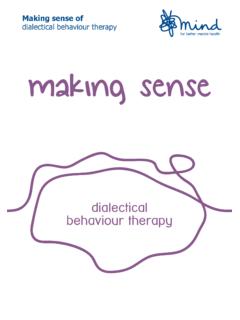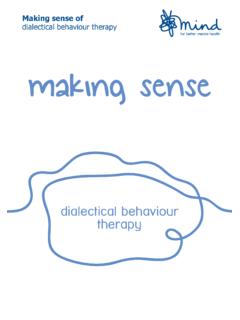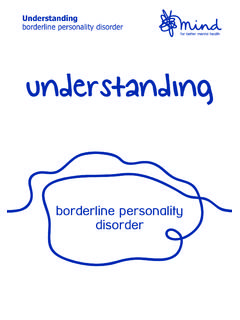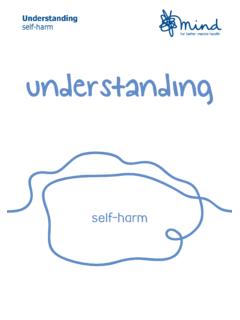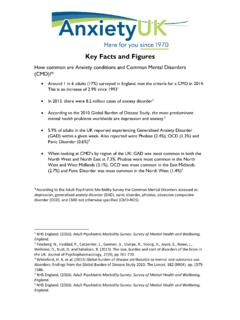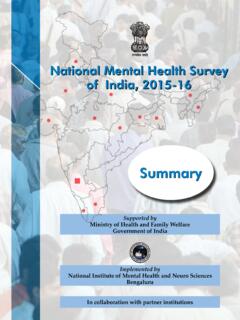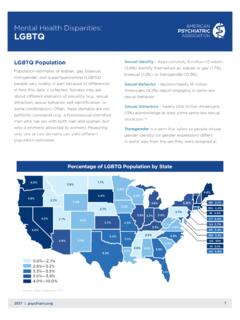Transcription of Mental health facts and statistics - Mind
1 Mind 2017 1 Mental health facts and statistics Key facts and statistics on Mental health problems and issues. If you require this information in Word document format for compatibility with screen readers, please email: Contents Introduction to statistics .. 2 How common are Mental health problems? .. 3 Key facts and trends .. 5 Mind 2017 2 Introduction to statistics Mental health is a broad topic, and understanding some of the facts and figures associated with it can help to put individual experiences in context.
2 This information is targeted at Mental health professionals, journalists and students. However, it is also our aim to present statistics in a way that makes them accessible to all those who are interested in Mental health . Note: The language used in these pages reflects the sources referred to. The use of such language does not imply Mind's automatic acceptance of it. Understanding the figures The frequency of Mental health problems is well documented statistically. However, these figures need to be treated with some caution.
3 Often widely differing figures will be given for the same Mental health problem, making it difficult to determine exactly how common it is. This is partly because these figures are not always measuring the same thing. For example, in order to reflect the fact that Mental health is not fixed but likely to change over time, a variety of different figures are used. The most common are: Prevalence this measures the number of people with a particular diagnosis at a given time. Lifetime prevalence this measures the number of people who have experienced a particular Mental health problem at any time in their lives.
4 Incidence this measures the number of new cases of a particular Mental health problem that appear in a given time period. Often these figures are compared to provide further information about a Mental health problem. For example, comparing the number of new cases (the incidence) with the number who are ill at any one time (the prevalence) can give us a rough idea of the average amount of time a Mental health problem is likely to last. Understanding the sample Another important factor is the kind of sample used to arrive at a particular figure.
5 Often the number of people treated by health professionals is used to determine how common a Mental health problem is. However, this is likely to ignore all those who have not come into contact with services. Furthermore, psychiatric diagnosis is often far from straightforward a person's diagnosis may be changed several times in the course of their treatment. An alternative approach is to take a sample of the whole population and interview people, according to a standard set of criteria, to see if they have a Mental health problem.
6 This Mind 2017 3 approach (known as a community survey ), although expensive and time consuming, is usually the most reliable. How common are Mental health problems? See References at the end of this section for a list of the referenced studies and surveys used to compile these statistics . Approximately 1 in 4 people in the UK will experience a Mental health problem each year [1]. In England, 1 in 6 people report experiencing a common Mental health problem (such as anxiety and depression) in any given week [2].
7 Are Mental health problems increasing? The overall number of people with Mental health problems has not changed significantly in recent years, but worries about things like money, jobs and benefits can make it harder for people to cope. It appears that how people cope with Mental health problems is getting worse as the number of people who self-harm or have suicidal thoughts is increasing [2]. How common are specific problems? Every seven years a survey is done in England to measure the number of people who have different types of Mental health problems [2].
8 It was last published in 2016 and reported these figures: Generalised anxiety disorder in 100 people Depression in 100 people Phobias in 100 people OCD in 100 people Panic disorder in 100 people Post traumatic stress disorder (PTSD) in 100 people Mind 2017 4 Mixed anxiety and depression in 100 people Estimates for bipolar disorder, psychotic disorder and personality disorders are usually measured over a person's lifetime, rather than each year. Estimates for the number of people with these diagnoses can vary quite a lot but the most recent reported findings are [2]: Psychotic disorder in 100 people* Bipolar disorder in 100 people Antisocial personality disorder in 100 people Borderline personality disorder in 100 people *Measured over the last year.
9 The survey also measures the number of people who have self-harmed, had suicidal thoughts or have made suicidal attempts over their lifetime: Suicidal thoughts in 100 people Suicide attempts in 100 people Self-harm in 100 people Note: these statistics have been taken from studies that have surveyed people living in private housing in England [2]. The figures do not include the number of people experiencing Mental health problems in hospitals, prisons, sheltered housing or people who are homeless.
10 Therefore these figures may underestimate the prevalence of Mental health problems. How accessible is treatment? Reports from both England [2] and Wales [3] suggest that approximately 1 in 8 adults with a Mental health problem are currently receiving treatment. Medication is reported as the most common type of treatment for a Mental health problem [2] References Mind 2017 5 [1] McManus, S., Meltzer, H., Brugha, T. S., Bebbington, P. E., & Jenkins, R. (2009). Adult psychiatric morbidity in England, 2007: results of a household survey .


